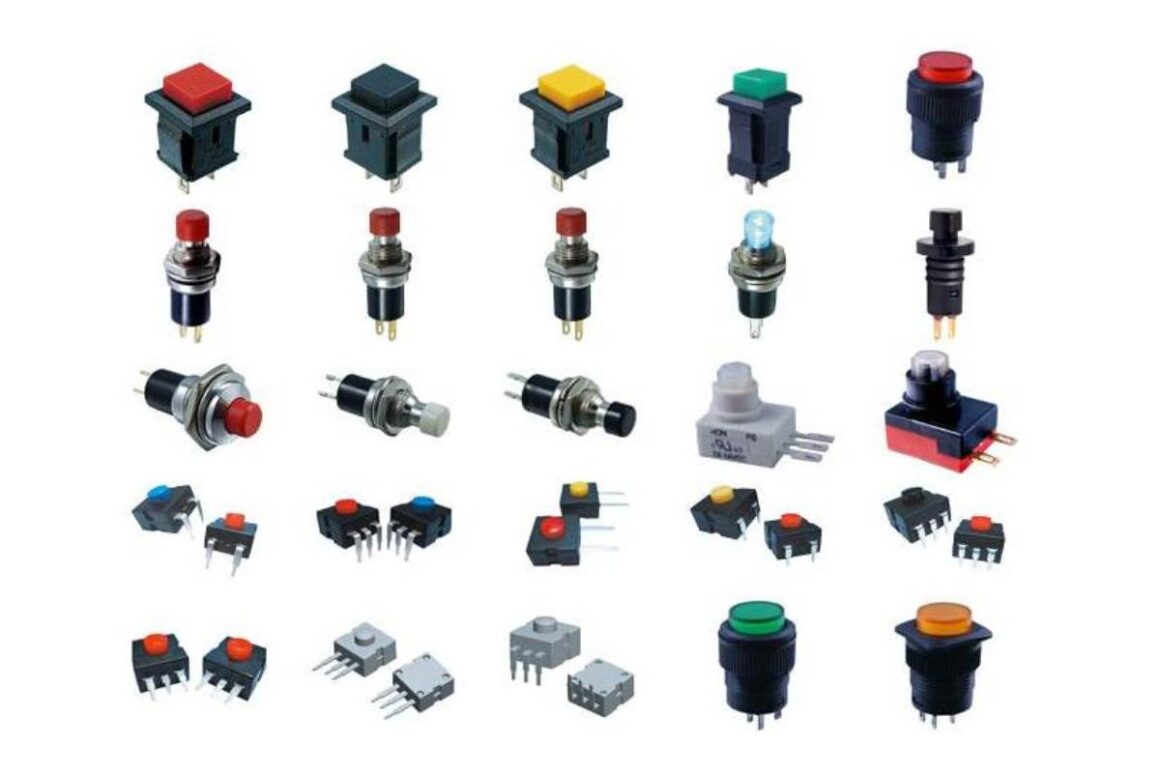In today’s world of automation and control, simple yet reliable components are essential for efficient and safe operation. Push buttons are one such component, playing a crucial role in various electrical systems.
Push buttons provide a convenient and user-friendly interface for controlling machinery, equipment, and processes. They are widely used in industrial settings, commercial applications, and even residential homes.
Types Of Push Buttons
Push buttons come in various group, each designed for particular applications:
- Momentary Push Buttons
These buttons remain activated only while they are pressed. They are commonly used for starting and stopping equipment.
- Maintained Push Buttons
These buttons remain activated after being pressed until they are manually released. They are often used for emergency stop functions.
- Mushroom Push Buttons
Mushroom push buttons have a distinctive mushroom-shaped design and are typically used for emergency stop functions. They are easily recognizable and provide a clear indication of the machine’s status.
- Selector Push Buttons
Selector push buttons have multiple positions, allowing users to select different modes or functions.
- Indicator Push Buttons
Indicator push buttons provide visual feedback, indicating the status of a system or process.
Functions Of Push Buttons
Push buttons serve a wide range of functions in electrical systems:
- Starting and Stopping Equipment
Push buttons are used to begin and stop machinery, equipment, or processes.
- Emergency Stop Functions
Emergency stop push buttons are used to quickly shut down equipment in hazardous situations.
- Manual Control of Processes
Push buttons can be used for manual control of various processes, allowing operators to override automatic functions.
- Signaling and Indication
Push buttons can be used to signal alarms, trigger indicators, or provide other forms of feedback.
Construction Of Push Buttons
Push buttons typically consist of the following components:
- Mechanical Components
The mechanical components include the button itself, the spring mechanism, and the contact assembly.
- Electrical Contacts
The electrical contacts are responsible for making and breaking the electrical circuit when the button is pressed or released.
- Enclosure and Sealing
The push button is housed in an enclosure that protects the internal parts and provides a suitable mounting surface. Push buttons may also be sealed to prevent the ingress of dust, moisture, or other contaminants.
Benefits Of Using Push Buttons
Push buttons offer numerous benefits:
- Reliability and Durability
Push buttons are known for their reliability and durability, providing long-term service with minimal maintenance.
- Easy Installation and Maintenance
Push buttons are simple to install and maintain, requiring minimal effort and expertise.
- Cost-Effective
Push buttons are generally cost-effective compared to other types of switches or control devices.
- Versatility in Applications
Push buttons can be used in a broad scope of applications, from industrial settings to residential homes.
Applications Of Push Buttons
Push buttons are broadly used in various industries and settings:
- Industrial Control Panels
Push buttons are essential components of industrial control panels, providing operators with a convenient way to control machinery and processes.
- Machinery and Equipment
Push buttons are used to start, stop, and control various types of machinery and equipment.
- Home Automation
Push buttons can be used in home automation systems to control lighting, appliances, and other devices.
- Security Systems
Push buttons are often used in security systems for arming, disarming, and activating alarms.
- Elevators and Escalators
Push buttons are use for calling elevators and escalators, as well as for emergency stop functions.
Safety Considerations
When using push buttons, it is essential to consider safety factors:
- Proper Labeling and Identification
Push buttons should be clearly labeled to indicate their function and prevent accidental activation.
- Emergency Stop Button Placement
Emergency stop push buttons should be placed in easily accessible locations and clearly marked.
- Lockout/Tagout Procedures
Follow proper lockout/tagout procedures to prevent accidental startup of equipment during maintenance or repair.
Choosing The Right Push Button For Your Application
When selecting push buttons, consider the following factors:
- Type of Push Button
Choose the appropriate type based on the desired function (momentary, maintained, mushroom, etc.).
- Contact Configuration
Select the correct number of contacts (single-pole, double-pole, etc.) based on the circuit requirements.
- Operating Force
Consider the required operating force (the amount of pressure needed to activate the button) and the desired tactile feedback.
- Sealing and Protection
Choose a push button with the appropriate level of sealing and protection for the operating environment (e.g., dustproof, waterproof).
- Color and Labeling
Select a color and labeling that are appropriate for the application and easy to understand.
By carefully considering these factors, you can choose the most suitable push buttons for your specific needs and ensure safe and efficient operation.
Conclusion
Push buttons are simple yet essential components in electrical systems, providing reliable and convenient control of various functions. By understanding the different types of push buttons, their applications, and safety considerations, you can effectively use push buttons to enhance the safety, efficiency, and functionality of your electrical systems.
Enhance Your Electrical Systems with Reliable Push Buttons
Ready to upgrade your electrical systems with high-quality push buttons? Schneider Electric offers a wide range of push button solutions, designed for reliability, durability, and versatility. Our push buttons are ideal for various applications, from industrial control panels to home automation.

